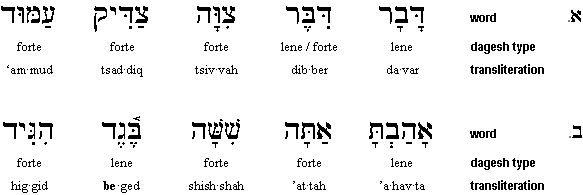|
Hebrew Syllables - |
||||||||||||||
|
Introduction to the dagashim |
||||||||||||||
|
Any Hebrew letter (except the gutturals) can have a dot inside of it called a "dagesh mark" (dagesh means "emphasis"). There are basically two kinds of dageshim that you need to know: the dagesh lene (kal) and the dagesh forte (chazak). |
||||||||||||||
 |
||||||||||||||
|
In the list above, notice that every Hebrew letter (except the gutturals Aleph, Hey, Chet, Ayin, and Resh) can appear with a dot inside - a dagesh forte. |
||||||||||||||
 |
||||||||||||||
|
In the example above, we notice first that the word has a dagesh forte in the Samekh. The value of this letter is "doubled," and we thus count the first "s" as a closing sound of the previous syllable (i.e., nis) and the second "s" as the first sound of the following syllable (i.e., si). We would transliterate the word as nis·si. |
||||||||||||||
|
Lene or Forte? |
||||||||||||||
 |
||||||||||||||
|
In the example above, notice first that the word has a dagesh in the Bet. Now, is this a dagesh lene or forte? Since it is preceded by a vowel (i.e., the Patach of the first syllable), the Bet must have a dagesh forte. |
||||||||||||||
|
The General Rule... |
||||||||||||||
|
If there is a "dot" inside a letter, "double" its value; but if it is a Begedkephat letter, double the value only if it is preceded by a vowel. |
||||||||||||||
|
Examples: |
||||||||||||||
 |
||||||||||||||
|
Summary:
|
||||||||||||||
|
Advanced Grammatical Note: |
||||||||||||||
|
|
||||||||||||||